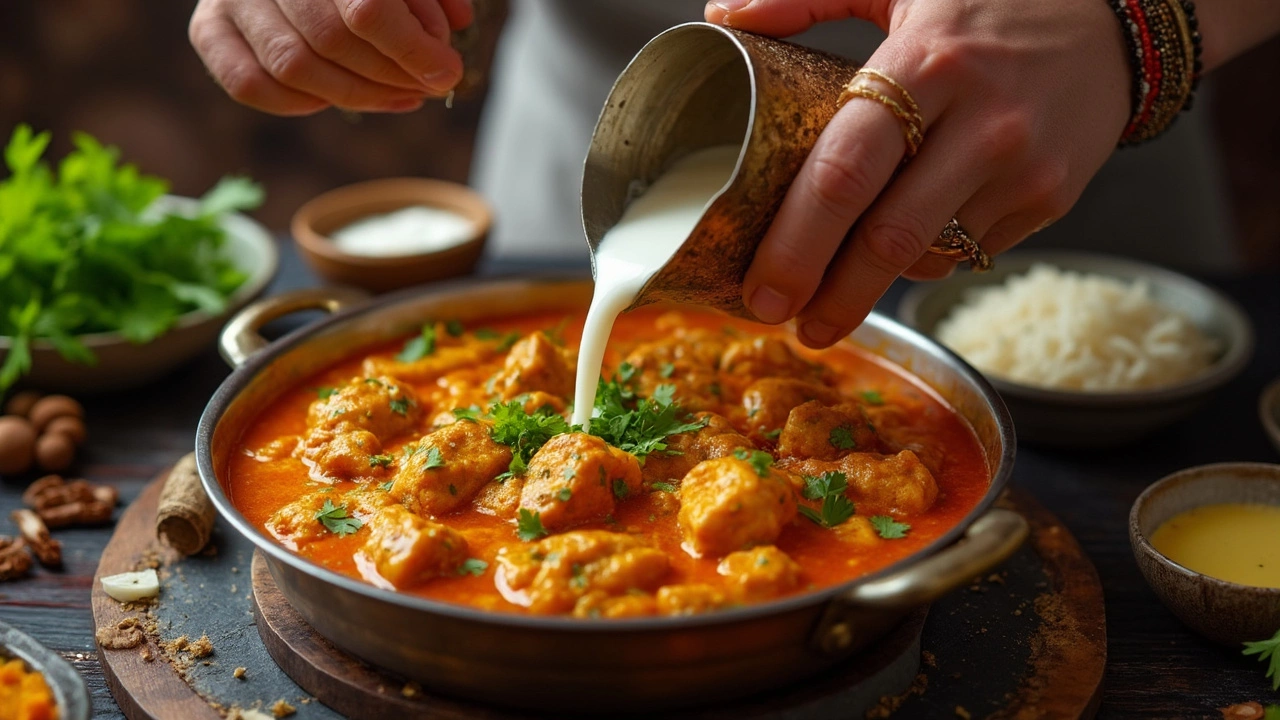Ever finished a pot of chicken curry and wondered why it turned out runny, even though you poured in plenty of coconut milk? You’re definitely not alone. Coconut milk is famous for giving curries a silky feel, but does it actually make them thicker? That depends on a few surprises most home cooks miss.
If you’re adding coconut milk just for thickness, here’s a quick reality check: coconut milk adds richness and a subtle sweetness, but on its own, it’s usually not enough to make curry thick. In fact, if you pour it in and walk away, you’ll probably end up with a thin sauce. It acts more like cream than a thickener, so if you want that classic, spoon-coating texture, you need a few more tricks up your sleeve.
- What Coconut Milk Actually Does in Curry
- Why Your Curry Might Stay Watery
- Easy Ways to Thicken Curries with Coconut Milk
- Extra Tips for Creamy, Dreamy Chicken Curry
What Coconut Milk Actually Does in Curry
First off, coconut milk is not a classic thickener. It works more like a fatty liquid that makes your chicken curry feel rich, smooth, and a little sweet. Most cans of coconut milk are about 60% water, with the rest being healthy fats and a touch of natural coconut flavor. So, when you pour coconut milk into your pan, you’re basically adding both extra liquid and creaminess at the same time.
It gives curries that lush texture everyone loves but doesn’t do much to thicken them up unless you simmer it for a long time. Even then, it won’t thicken as much as dairy cream or cornstarch mixtures. What coconut milk really does best is mellow out spicy flavors and bind the tastes together. It transforms harsh heat from chilies into a cozy, balanced dish without making the whole thing greasy or heavy.
Here’s a quick breakdown on what to expect when you add coconut milk to curry:
- Adds creaminess and a velvety texture
- Makes the sauce taste less sharp or acidic
- Balances spicy notes with a subtle sweetness
- Boosts the liquid in your pot (so curry might look runnier at first)
Most brands of coconut milk aren’t designed as thickeners—unless the can says “coconut cream” (which is thicker and more concentrated), expect your curry to end up smooth, not pudding-like. Next time you’re checking the grocery shelf, grab the full-fat type instead of “lite” coconut milk if you want things extra creamy. Here’s a snapshot of the difference:
| Type | Fat Content | Main Effect in Curry |
|---|---|---|
| Full-fat coconut milk | 20-22% | More creaminess, slightly thicker |
| Lite coconut milk | 6-8% | Less creamy, very watery |
| Coconut cream | 25%+ | Thick, super rich sauce |
So, if you expected coconut milk to magically thicken your curry, it’s good to know it actually brings more liquid and flavor than thickness. The real magic happens when you pair it with the right tricks and let it simmer down.
Why Your Curry Might Stay Watery
So, you’ve followed your favorite chicken curry recipe, poured in a can of coconut milk, and now you’re staring at a pot of soup instead of thick, luscious curry. It happens a lot, and honestly, the reasons are pretty straightforward once you know what’s going on in the pot.
First, not all coconut milk is created equal. The stuff labelled “lite” or “low fat” has way more water than classic, full-fat versions. Using these can thin out your chicken curry right away. Even regular coconut milk from some brands simply has more water stirred in. A quick way to check: good coconut milk will have a thick, creamy layer on top when you open the can—if it’s all liquid, that’s a red flag for runny curry.
Next up, the cooking process itself matters. If you add the coconut milk too early or keep the lid on tight, all that steam and excess liquid stays trapped in the pan. Instead of reducing and thickening, your curry just collects water. Some people even add extra water or broth, thinking it’ll mix things better, but this often just waters down the whole dish. Vegetables like tomatoes, onions, or zucchini also release lots of moisture when they cook, making things even more runny—especially if you haven’t sautéed them long enough first.
Another reason is pretty simple: timing. Thick curry takes a bit of patience. If you’re in a hurry and turn off the heat before enough liquid has boiled off, you get a soupier sauce. Also, don’t forget that curry thickness changes as it cools down; it can seem too thin in the pot but thicken up after sitting a few minutes.
Check out how each factor can impact your curry’s thickness:
| Factor | Effect on Thickness |
|---|---|
| Lite/Low-Fat Coconut Milk | Makes sauce runny |
| Regular Coconut Milk (low quality) | Usually thin, watery |
| Added Water/Broth | Thins sauce further |
| Lid On | More liquid, less reduction |
| Cooked Vegetables | Release moisture, thins sauce |
| Short Cooking Time | Not enough reduction, sauce stays thin |
So when your chicken curry comes out watery, it’s usually not your fault—it’s one (or several) of these classic routines. The good news? There are easy ways to fix and avoid this, which I’ll break down in the next section.

Easy Ways to Thicken Curries with Coconut Milk
So you’ve got your coconut milk in the pot, but your chicken curry still looks more like soup than sauce. No stress. There are several good ways to thicken up your curry and make it cling to your rice just right.
- Simmer it longer: This is the most basic trick. After you add the coconut milk, keep the curry on a medium simmer with no lid. Extra water will evaporate off, and the sauce naturally thickens. Stir often so nothing sticks to the bottom. Give it at least 15 or 20 minutes.
- Add a starch: Cornstarch or arrowroot are quick fixes. Mix 1-2 teaspoons with cold water until smooth, then stir it into your curry at the end. Potato starch works too. Don’t dump the powder straight in, or you’ll get clumps.
- Use tomato paste or pureed onions: Both not only thicken the sauce, but boost flavor. Onion puree is old-school in Indian curries. Pop half an onion in a blender with a splash of curry liquid, then stir it back in and simmer till thick.
- Coconut cream over coconut milk: If you can get your hands on coconut cream, swap it for regular coconut milk. It’s way thicker and makes the sauce instantly richer. You can also scoop the heavy part off the top of a chilled can of coconut milk and use that.
- Let potatoes or lentils do the work: Add a handful of diced potatoes or red lentils to your curry early on, and they break down as they cook. This thickens the curry without changing the flavor by much.
Want to see how those starches compare? Here’s a little cheat sheet:
| Thickener | Amount (for 4 cups curry) | Thickening Speed |
|---|---|---|
| Cornstarch | 1-2 teaspoons | Very fast (1-3 min) |
| Arrowroot | 1-2 teaspoons | Fast (1-3 min) |
| Potato Starch | 1 tablespoon | Fast (2-4 min) |
| Cooked Red Lentils | 1/4 cup dry | Slower (10-15 min) |
Quick note: Don’t go wild with thickening agents. Too much starch and your curry will get gummy. Add a bit at a time, stir, then wait a minute or two before adding more.
Extra Tips for Creamy, Dreamy Chicken Curry
Getting that perfect creamy texture in your chicken curry with coconut milk is actually pretty simple if you know what to tweak. First off, always shake the can of coconut milk before you open it—the thick cream at the top is gold for your curry. Opt for full-fat versions, as light coconut milk has way less cream and won't give you the same dreamy result.
If your curry still seems thin, let it simmer uncovered to let some of the water evaporate. This concentrates flavors and thickens things up without you throwing in any weird thickeners. Want it even richer? Try blending in a handful of soaked cashews or a spoonful of creamy peanut butter—trust me, it works.
Curry expert Maunika Gowardhan says, "A slow simmer is key. The longer you let your coconut milk-based curry cook gently, the thicker and creamier it becomes."
Some folks swear by tossing in cooked, mashed potatoes or a bit of cornstarch slurry (just mix a teaspoon of cornstarch with a splash of water, not straight into the pot). Those work, but keep an eye on the taste—too much and you can dull those awesome spices.
- Use bone-in chicken if you can—it adds natural body and depth to the sauce.
- Sauté spices in oil before adding coconut milk. That fat helps bring out flavor and thickness.
- Don’t drown your curry in liquid from the start. Add a little at a time and top up if needed later.
- Serve with rice or naan to soak up that thick, rich sauce. No point making it creamy if you’re not gonna enjoy every drop!
| Brand | Fat Content (g) |
|---|---|
| Aroy-D | 17 |
| Chaokoh | 18 |
| Goya | 15 |
| Thai Kitchen (Lite) | 6 |
Spot the difference? Choosing the right coconut milk makes a huge impact in how thick and rich your curry turns out. So next time, grab a full-fat version and try one of these tips. Your taste buds (and dinner guests) will absolutely thank you.
